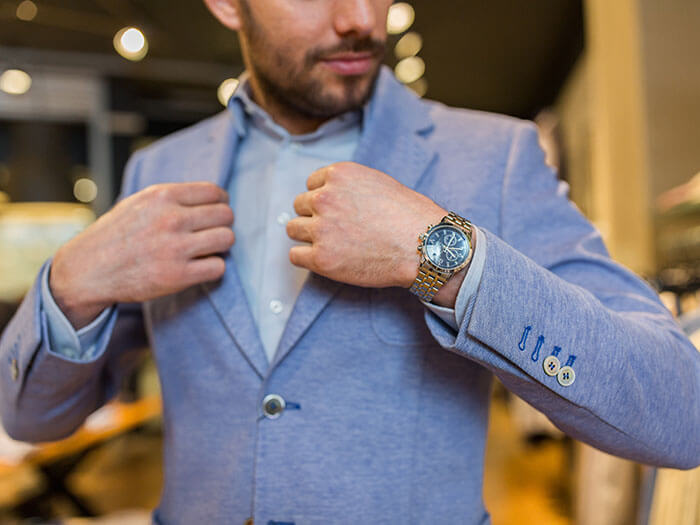A look at the global picture indicates men shop less frequently than women, however they are more likely to purchase luxury items than their female counterparts.
This is because male shoppers tend to focus on quality and style, choosing to purchase high quality garments which will last for a significant amount of time.
Men’s designer apparel is projected to grow by US$153 billion between 2020 and 2024, with a CAGR of 6%. US men’s designer apparel projected to reach US$9.39 billion by 2025, increasing from US$8.2 billion in 2021.This figure is particularly interesting given the overall luxury market is only expected to grow by 3% in the next four years to US$318 billion. Luxury brands like Hermès, Lanvin, Gucci, Ralph Lauren, Dolce & Gabbana and Prada have taken notice and now all boast men-only flagships.
The luxury menswear market growth is expected to be driven by strong demand in China, India, and the UAE – countries where young middle-class men are pushing the cultural norms of menswear and taking an increasing interest in their appearance. The rapid growth of luxury menswear in these regions will balance out slower growth in EU markets like Italy, France, Germany and the UK where men favor fast-fashion brands over premium labels.
Another key difference between male and female shoppers is that men tend to prefer brands they know and trust. This trend is particularly evident in emerging markets like India and the Middle East where the consumption of luxury goods is driven by status-related purchases. Men in these countries know and trust western brands, having grown-up being exposed to them online and on television.
Market watch
Although menswear is a global phenomenon, retailers can benefit from targeting countries where the most growth is expected.
For example, of the US$91.9 billion overall menswear market growth between 2009-2014, China was responsible for US$31 billion of that growth. In 2020 alone, China was responsible for US$91 billion revenue in the men’s apparel market.
For retailers planning to expand their menswear offering globally, the key markets are:
- China
- India
- UAE
- USA
- Mexico
- Saudi Arabia
- Argentina
- Canada
- Spain
- Turkey
A Closer Look at Three Key Emerging Regions
-
Asia Pacific – China, Japan and India
China and Japan are both home to rapid economic and purchasing power growth, in turn creating a cycle of disposable incomes and spending.
This region is expected to continue its significant growth as the middle and upper-class populations expand. Combined, China and Japan represent two thirds of the Asia-Pacific menswear market, and globally China accounts for 19.9% of menswear sales. Japan is the third largest global menswear market with a 6.66% share.
The Asia Pacific region is expected to account for over 40% of global mens and womenswear market by 2024. Ankita Roy, Retail Analyst at GlobalData, comments:
“The APAC countries are catching on to the fashion trends with growing awareness of international brands through digital media platforms. Collective factors such as economic growth, fashion awareness and increasing propensity to consume offer significant growth opportunities in womenswear and menswear sales in the APAC countries, especially India and China. To capitalize on this, both domestic and international retailers must launch aggressive market strategies.”
Japanese brand Uniqlo is the leading brand in the region and is now expanding its Chinese presence to capitalize on this popularity.
-
Latin America – Mexico, Argentina and Brazil
Latin America is home to a male consumer who is much more conscious of his appearance than his counterparts in developed markets. This image-conscious culture places high emphasis on status, using clothing and brands to illustrate the male consumer’s success.
Brazil is the largest market in the region, accounting for US$14 billion in menswear sales. Argentina has demonstrated the highest absolute growth value, with a sales increase of $9 billion in 2020.
-
Middle East and Africa – South Africa, Saudi Arabia & Morocco
The Middle East and Africa is another region where CAGR is outpacing the menswear global average. Saudi Arabia and South Africa are two countries driving the overall CAGR of 7%, boasting CAGRs of 8% and 7% respectively. The growth is credited to the shift from more traditional clothing to incorporating new styles and colours in menswear.
Value growth is outpacing volume growth, suggesting this region is keen to buy aspirational brands and want high-quality international brands that they know and trust such as Adidas, Nike, Tommy Hilfiger, Levi’s and fast fashion brands like H&M and Zara.
Morocco has shown surprising growth, with Nike, Adidas, and Puma responding to the country’s interest in men’s sportswear and footwear, leading to a CAGR of 9% in Morocco.

